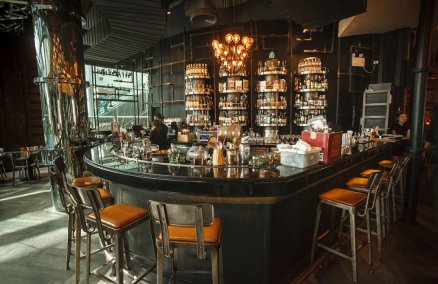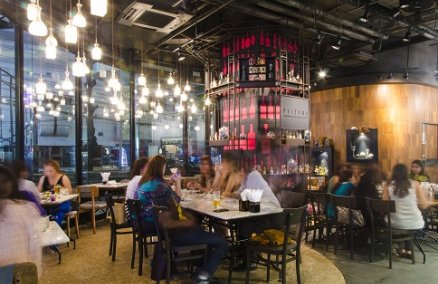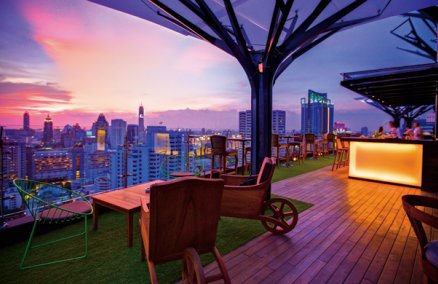Thailand—and perhaps Bangkok, most of all—has been traumatized by the demonstrations and military crackdown that killed 91 people and left parts of downtown in smoldering ruins a few months ago. Perhaps because of our disapointment with politics, or because of increasing censorship, there’s a feeling that this trauma isn’t being addressed by the media. That has made artists incredibly important voices for the past few months. Here, we speak to some moderate artists and a couple of resolutely anti-red ones, too. We’d have spoken to hardcore reds to balance things out but their absence in the capital, or silence (see our boxes on censorship), speaks quite loudly. Finally, we ask if art is a way to go beyond color politics and elevate us to something better and higher than what the yellow/red divide can offer.
Teerawat “Kage” Mulwilai
With his latest performance Flu-O-Less-Sense, seasoned actor/director and B-Floor founder Teerawat “Kage” Mulwilai revisited the media’s portayal of the Apr-May 2010 events both from pro- and anti-government perspectives. Taking a break from work on a sequel to his acclaimed production, Kage shares his take on artistic, social and political issues.
 Explain your performce.
Explain your performce.
Flu-O-Less-Sense talks about this contagious disease which induces the state of senselessness. It’s a performance without script, well, unless you call gibberish script! I used a lot of visuals to help get my points across. News clippings were projected onto the stage’s floor and on screen. I wanted to make the audiences feel as if they were in those scenes from the news, and therefore part of the situation. It also dealt with the messages we received from the media. Like it or not, we were all involved one way or another. I wanted to portray things as they are, or at least, as portrayed by the government and TV channels like ASTV and Red Shirt TV. Who would you choose to believe when everybody tried to portray themselves in their best light possible? The performance wasn’t biased, because I laid it all out there. The show ran parallel with the Thai context. We raised questions and it was up to the audiences to find hidden symbols.
What was the audience’s reaction?
They said they found it quite extreme, like a punch in the face! They said it made them feel like they were back in May and the few months leading up to the clash. You know, that overwhelming feeling of not knowing who to trust, what news channel to believe. I really had no answers for the audience. I can’t wait for them to see the sequel, which will be called Flu-All-Right. But is it really alright? We’ll see.
Do you ever practice self-censorship?
No. I do cringe sometimes, though, during rehearsals. For example, when I was doing the show called Sun Dan Ka, which talks about Anupong Chantorn’s notorious paintings depicting monks with beaks, I thought it was a bit much. But then I told myself that I wasn’t doing it just for the sake of being controversial; I had a point to make. Also, the kind of people who come to see my works are usually the understanding kind—more progressive, if you will. So, I don’t really have anything to worry about. Diversity of thoughts should be encouraged, not restricted. I strongly believe that the “We Love Bangkok” campaign is just propaganda. They miss the mark completely. Thai people are not school students who need to be told to love the country. It’s worrying that something as basic as common sense has to be taught and advertised in our country.
Were you always political?
I’ve always been working on social and political issues. My productions tackle all kinds of issues from sexuality to the Holocaust. But at the end of the day, each production has the goal of provoking thought. I doubt that democracy actually works, because from my experience of living and working in several countries, politicians are the same everywhere. If it’s meant to work, then how come people seem to constantly go against the government?
Who holds the truth: artists or politicians?
At the end of the day, I’m still just one of the many Thai people who has every right to express my opinion. Artists are perhaps a bit more special because they are capable of presenting their thoughts and ideas in a non-obvious way. My work doesn’t usually provide the answer. It makes people ponder on the matter.
Vasan Sitthiket
At 53 years old, veteran artist/poet Vasan Sitthiket remains passionate about politics. Best known for his controversial, satirical works, Vasan recently expressed his opinions on the May clash in “17-19 May 1992” and “19 May 2010,” shown at the Akko Art Gallery’s 20/20 exhibition which ended last month.
 What do your paintings mean?
What do your paintings mean?
They’re an analogy to one another and are pretty self-explanatory. People tend to think that my exhibitions, particularly the “Ten Evil Scenes of Thai Politics,” which was showing during the beginning of the red protests, was aimed at Thaksin, but actually it came from my accumulated displeasure with the government. I painted “Blood Rain” [currently on display at Return Ticket: Thailand-Germany, see +art page 40] to let the politicians know that we know what they’re up to. It’s almost like a plea, if you will, for them not to corrupt this country any further than they have already.
Ever practiced self-censorship?
Never. The artist’s duty is to be a voice for the public. The state of censorship can’t touch artistic expression. However, we have to be careful as some groups of people will use freedom of speech as a disguise, or with ulterior motives. It’s not an individual, it’s a process, and the victims have always been the people. We’re in the 21st century and there’s really no need for censorship. People will eventually find out if you leave certain things out. I know I don’t need to be censored. It all depends on what your motives are. I’m doing all this to speak out for the public. Some claim to do it for the democracy, when in fact it’s for Thaksin. I think our country has a lot of freedom—crazy freedom. We just need to learn to make use of that freedom and make it politically correct—so to speak. We’re at the verge of doom, and unfortunately those in power are not wise enough to salvage the situation.
What was the audience’s reaction?
With the color separation, people have become noticeably more sensitive about my works. But c’est la vie. I’ve got to say what I’ve got to say. There’s no point beating around the bush. If people cringe when they see my work, so be it. The concept of kreng jai, most of the time, backfires in Thai society. People are too afraid of being blunt, which is not a good thing.
How did you first get involved in political art?
I grew up just after the clashes between the students and army on October 14 in 1973, when the thinkers and writers re-emerged from their hiding places. I’ve always been an artist who’s determined to document our country’s political and social changes and development. I’ve always been involved with mobs and rallies for as long as I can remember. As an artist, you’re somewhat obligated to poke your nose into matters. I believe that artists should also act like journalists.
Can artists really change society?
I was involved in a lot of demonstrations to get rid of dishonest politicians. I brutally criticized them through the best ways I know; by making art and writing poems allegorizing them as animals. We elect people to run the country on our behalf, not rob us of resources for their personal gain. I’ve always considered myself anti-government because, in my opinion, state power is the people’s arch enemy. We need morally decent people to run our country, not a bunch of crooks. To me, our parliament is nothing but a thief’s lair. All this was reflected through my works titled “New Bangkok Skyline,” which were a series of satirical election posters for the fictitious Artist Party, aimed to take a jab at Thai Rak Thai’s populism back in 2008. Democracy can never happen in a society where the people in power abuse and spoil the system.
What’s the difference between art and politics?
To me they’re one and the same. I’m not above politics; I’m all about politics.
Sakarin Krue-on
A regular at major international art events like the Venice Biennale, Maehongsorn-native artist Sakarin Krue-on returns to his home turf with Manorah and Best Friends of the Snake, an exhibition combining a short film, paintings and images. Here, the Silapathon Award winner tells us about his political stance.
 What does the show mean?
What does the show mean?
This particular exhibition came from a project called “Two men look out through the same bars: one sees the mud and one sees the star.” It talks about the current situation in our country, using a series of symbols. It focuses on two polarizing ideas, stars obviously mean something idealistic whereas mud is something undesirable. People perceive things differently and that is the core of our problem. People today tend to forget their own identity and follow others without thinking. I won’t reveal all the metaphors, though, the rest is up to you to explore.
Have you ever left something out for fear of the authorities?
Yes, but I never ditch the idea completely. We artists seem to manage to get away with it most of the time. Since the art scene in Thailand is quite small, we also get censored by society and art critics.
What was the audience’s reaction?
Someone came up to me and told me that they appreciated the fact that I managed to make such a sensitive issue lighter and easier to digest. The exhibition spoke for them in a way. The audience’s smiles at the end of the show are a great sign, because I know that they got my message. I mean, you could easily get into a big fight if you sat and talked about this kind of thing with someone.
Do you think you’ve always been political or you’ve been forced to speak up because of recent events?
I’ve always been outspoken about politics. I often tap into the concept of “equal opportunity,” which seems to be prevalent in every form of politics, whether it is communist, Marxist or democracy. Democracy, to me, is dictatorship of the majority, which leads to capitalism. I came up with Manorah because I want to portray what’s currently happening in our society. It’s still a shock to me what happened back in May and I am still really surprised that no one didn’t try to stop it or prevent it from happening.
What’s the difference between artistic and political expression?
As an artist I see no difference. Art is freedom of expression. Countries in which art flourishes are usually the ones that are open to ideas. I’m not above politics, but if I have something to say, then I’ll say it. That’s an artist’s job. You can predict what our society will be like in the next ten years from the art we see today.
Olivier Pin-Fat
Known for his realistic and gritty portrayal of methamphetamine addicts in an exhibition titled Ya Ba, Olivier Pin-Fat is an England-born, French-Chinese photographer. His exhibition “Bangkok.Aftermath,” will be displayed as part of the joint exhibition Rupture—Cause and Effect, held from Nov 25-Jan 9, 2011 at the Bangkok Art and Culture Center.
 How do these pictures provide a new reading of the May events?
How do these pictures provide a new reading of the May events?
The images were taken during the course of one-day only—Friday, May 21. I’ve been living in my adopted city of Bangkok for 17 years now. During Thailand’s recent political “rupture,” I found myself getting increasingly frustrated by the mainstream media’s portrayal of the protests. I felt very strongly that the complexity of what was occurring, and why, was—photographically speaking—being over-simplified and flattened into a monosyllabic aesthetic of iconic stereotypes. The Western media in particular was, and is, guilty of perpetuating and disseminating these almost Biblical archetypes. I felt many photojournalists who covered events for the media unwittingly utilized a more biased, romanticized and sometimes clichéd visual language. Images that were quickly understood yet took a subtle pro-Red Shirt position.
What’s the objective?
The works (31 images from this series) will be shown at the Bangkok Art and Culture Center, alongside two Thai artists, one German, one French and one Sino-British. It’s a cohesive but deeply disturbing and blistered visual stream of consciousness that looks beyond media bias and directly into the dark heart of the matter. It creates a sense of remembrance—lest we forget. We feel that Thai society is somewhat reluctant to face the recent past, and so this is our way to introduce something to and for the Thai general public that will hopefully raise questions to facilitate debate and discussion. It will get a lot of exposure, and this is very important. A sense of collective healing really needs to take place, so history doesn’t endlessly repeat itself, and if we can contribute in any way, through art or through any other means, then we must try.
Do you feel that you’re a political artist?
I think everyone is political in some way or another. It’s human nature. I tend to avoid political discussions that have recently and maddeningly been polarized into these ‘red or yellow’ and ‘there is no other color’ camps. A journalist recently accused me of being staunchly yellow for not being pro-red. If you’re not ‘this’ then it means you’re ‘that.’ I’m not defined by a two-toned color scheme. It can all get very infuriating.
Do we need artists to comment on politics?
It all depends on the artistic commentary being presented, doesn’t it? That can range from the banal to the timeless. It’s all relevant but not all necessarily effective. Look at Picasso’s Guernica in response to the bombing of the Basque country during the Spanish Civil War. Yes, I tend to avoid political commentary as I often find the sophism is self-serving and transparently so. I tend to disbelieve politicians. That said, there have been some great, visionary and impassioned political leaders in history, like Martin Luther King Jr.
MANIT SRIWANICHPOOM
Manit Sriwanichpoom, of Pink Man fame, has long criticized Thailand’s entrenched elitism and consumerism. But for him, the Red Shirts were not fighting for a new system.
 Are you working on anything as a reaction to the protests?
Are you working on anything as a reaction to the protests?
It’s very difficult to react so soon. I’m in trauma. You have to gradually process all the elements in your consciousness. It’s a loss of direction. Like getting hit by a car.
Do you worry about increased censorship?
People say the climate of censorship is getting stronger. But I think the question is, “What are we doing? What is the purpose of doing that?” If we want to criticize the government, say anything to undermine any side, I think it is too soon. I agree with Abhisit that the government needs reform. But what is happening to the reform committee set up by Abhisit? It’s like a bunch of old people brainstorming—but this shouldn’t be about old men. Everybody should be involved. Thailand has to change, but people in power have to sacrifice and decentralize. We tried in the 1997 and in 2007 constitutions. But decentralization was never implemented.
But how can the conversation take place if everyone isn’t allowed to speak?
We can talk about reform. But accusations will take us nowhere. People died and the government needs to investigate that. Maybe some people were not just killed by the army? What if the Reds killed each other to prompt international intervention? If we still are talking about this we go nowhere. What’s the point of accusing each other. We’re going in circles. I don’t want to talk about this. What interests me is how Abhisit will start reform and how it will happen. I hope that the media can play a key role pushing reform. The Western media just hooked up with this [blame] game. We want real change. I want the media to be part of change, not part of the game.
Are you angry?
I’m annoyed now. I ask: can you tell me something substantial? Not blah blah blah. If you want change tell us what you want. Don’t just tie ribbons at an intersection. You want to change the government? You just change the head. The body is the same. It’s rotten. This is a 150-year old problem. We need reform.
State of Censorship
The Top Thai Attacks on Art
Politically-charged exhibitions
















 Explain your performce.
Explain your performce. What do your paintings mean?
What do your paintings mean? What does the show mean?
What does the show mean? How do these pictures provide a new reading of the May events?
How do these pictures provide a new reading of the May events? Are you working on anything as a reaction to the protests?
Are you working on anything as a reaction to the protests?



